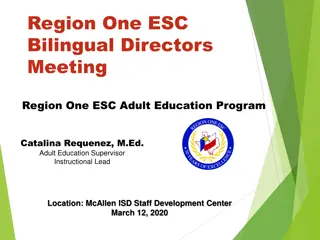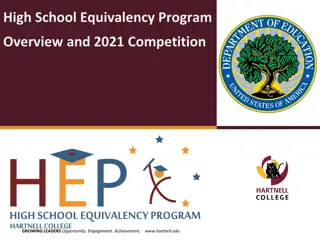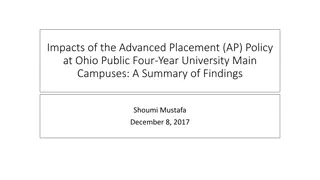Course Equivalency Project (CEP)
Database-driven Course Equivalency Project (CEP) in Oklahoma simplifies course transfer and credit recognition between institutions. It offers a comprehensive guide on course equivalencies, student learning outcomes, and institutional obligations, aiming to streamline the academic pathway for students. Visit the State Regents website for detailed information.
Download Presentation

Please find below an Image/Link to download the presentation.
The content on the website is provided AS IS for your information and personal use only. It may not be sold, licensed, or shared on other websites without obtaining consent from the author.If you encounter any issues during the download, it is possible that the publisher has removed the file from their server.
You are allowed to download the files provided on this website for personal or commercial use, subject to the condition that they are used lawfully. All files are the property of their respective owners.
The content on the website is provided AS IS for your information and personal use only. It may not be sold, licensed, or shared on other websites without obtaining consent from the author.
E N D
Presentation Transcript
Course Equivalency Project (CEP) Angel Icenhour Director of Concurrent Enrollment Programs
Course Equivalency Project What is the CEP? A database containing faculty-generated course equivalencies for Oklahoma institutions. 48 disciplines 8,072 courses Who Participates? Public institutions and HLC accredited private institutions. How does the CEP Benefit Students? Gives students the ability to see where their courses will transfer or where they can take a specific course to bring back to their home institution. Ultimately, saving them time and money on their journey to degree completion. Visit the State Regents website for more information on the CEP.
Course equivalencies are tables of courses that are transferable among Oklahoma public colleges and institutions (as well as some private institutions). Each table displays equivalent courses at each college and university and is organized by academic discipline, such as biology or history.
COMMON COURSE DESCRIPTION AND STUDENT LEARNING OUTCOMES STUDENT LEARNING OUTCOMES COMMON COURSE DESCRIPTION A common course description is a broad overview of the course. Student learning outcomes are statements that specify what students will know, be able to do or be able to demonstrate when they have completed the course.
EQUIVALENCY REQUIREMENTS Common course descriptions must overlap by 75% or more to determine equivalency. Added in 2017 - All student learning outcomes are required to be on each participating institutions syllabi. These outcomes are developed by faculty and are developed at a minimum (3-5).
Equivalencies are based on academic year
If your course is listed under a category, you are obligated to accept every other course in that category as equivalent to yours and every other institution is under this obligation with your course.
CEP CYCLE OVERVIEW: WE ARE HERE! STATE REGENTS APPROVAL MATRIX POSTED ONLINE INSTITUTION REVIEW FACULTY REVIEW INSTITUTION 2ND REVIEW COI APPROVAL MAY - AUG SEPT OCT - DEC FEB MARCH APRIL
ACADEMIC VICE PRESIDENT ROUND I & II
FACULTY ROUND 12 Disciplines COI Facilitator/Faculty Chair Objectives Review current content Develop SLOs Review Syllabi for NEW Course Additions 2023 Faculty Meeting - 313 American Indian Studies American Sign Language Chemistry Business Communication Biological Science Criminal Justice Physical Science Economics German Theatre English Humanities
Faculty Meeting Sheet (create version)
Common Course Description and SLOs (modifications and new) https://docs.google.com/forms/d/1nDYLnVGKFZBin-RXGDXZzM7opAWZjcdTzvArur7Zkt8/edit
Faculty Meeting Sheet (Import version)
NOTES 1. If a student transfers a lower division (1000-2000) course to an institution that offers the course at the upper division level (3000-4000), the lower division course will transfer as equivalent in content but not as upper division hours. 2. To receive full transfer credit, all courses in the sequence must be completed. Single courses will transfer at the discretion of the receiving institution. (Students should contact their institution in order to determine what additional course(s) is/are required for full transfer credit.) 3. If possible, students taking courses presented in sequence (I.e., I and II) should try to complete both courses at the same institution. 4. The degree requirements for history include approximately 15 to 18 semester hours of lower division work and from 21 to 36 hours of upper-division work. 5. This course requires a lab component be successfully completed simultaneously in order to receive full transfer credits. (2010- 2011) 6. If course prerequisites are not equivalent, the receiving department reserves the right to require the course to be taken at the 3000 level. 7. No required course sequence is to be inferred from the course numbering. 8. At least 75% of the lab component must be face-to-face instruction (as opposed to online instruction). If not, such courses will transfer at the discretion of the receiving institution. 9. Any lower division course will equate to a comparable lower division course should such a course exist. 10. TBD-to be determined-means the course is currently being created at the institution and does not yet have an assigned course number/prefix; however, the course has been pre-approved as a course equivalent in this category by the appropriate faculty group. 11. Placement exam required in order to receive full transfer credits in the major
Ms. Angel Icenhour Director of Concurrent Enrollment Programs Oklahoma State Regents for Higher Education aicenhour@osrhe.edu SCAN ME!























